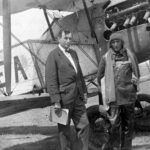The Air National Guard (ANG) stands as a vital component of the United States Air Force, providing crucial support both domestically and abroad. A key aspect of their identity and professionalism is their uniform. Understanding the Air National Guard Uniform is essential for service members, veterans, and civilians alike. This guide will delve into the intricacies of the Air National Guard uniform, exploring its components, regulations, and significance.
A Brief History of the Air National Guard Uniform
The Air National Guard’s uniform history mirrors that of the U.S. Air Force, evolving from Army Air Corps uniforms to the distinct styles worn today. Initially, Air National Guard units adopted the uniforms of their parent branches. However, with the establishment of the Air Force as a separate branch in 1947, the ANG transitioned to Air Force uniform standards. Over the decades, these uniforms have adapted to reflect changes in technology, operational needs, and military fashion, always maintaining a standard of professionalism and functionality.
Components of the Air National Guard Uniform
The modern Air National Guard uniform encompasses several variations, each designed for specific duties and occasions. Here are some of the key components:
Airman Battle Uniform (ABU)
The Airman Battle Uniform (ABU) is the primary field and utility uniform for the Air National Guard. Made from a durable, fire-retardant material, the ABU is designed for comfort and functionality in operational environments.
- Camouflage Pattern: The ABU utilizes the Air Force’s distinctive tiger stripe camouflage pattern, designed for effectiveness in various terrains.
- Blouse and Trousers: The uniform consists of a blouse and trousers, featuring multiple pockets for carrying essential gear.
- Boots: Standard issue boots are typically sage green or black and designed for durability and support in demanding conditions.
- Headgear: The ABU is typically worn with a boonie hat or patrol cap, often adorned with rank insignia.
Operational Camouflage Pattern (OCP) Uniform
In recent years, the Air Force and Air National Guard have transitioned to the Operational Camouflage Pattern (OCP) uniform, also used by the U.S. Army. The OCP is designed for improved concealment in a wider range of environments compared to the ABU.
- Camouflage Pattern: The OCP features a multi-terrain camouflage pattern consisting of greens, browns, and tans.
- Similar Design to ABU: The OCP uniform maintains a similar blouse and trousers design as the ABU, with comparable pocket configurations and features.
- Phase-in: The transition to OCP uniforms has been a phased process, with the OCP gradually replacing the ABU as the standard field uniform.
Service Dress Uniform
The Service Dress Uniform is the Air National Guard’s formal uniform, worn for official ceremonies, parades, and office environments. It presents a sharp and professional appearance.
- Service Coat: A blue coat with silver buttons and rank insignia worn on the sleeves.
- Trousers or Skirt: Matching blue trousers for men and a skirt option for women.
- Service Cap: A peaked cap with the Air Force emblem.
- Light Blue Shirt: Worn underneath the service coat.
- Necktie or Neck Tab: A silver-gray necktie for men and a silver-gray neck tab for women.
Flight Suit
For Air National Guard aircrew and certain support personnel, the flight suit is a practical and essential uniform. Designed for flight operations, it offers comfort, protection, and functionality within aircraft.
- Sage Green or Tan: Flight suits are typically sage green or tan in color.
- Nomex Material: Often made from Nomex, a fire-resistant material.
- Multiple Pockets: Features numerous pockets for flight-related tools and documents.
- Rank and Patches: Typically adorned with rank insignia, unit patches, and name tags.
Uniform Regulations and Standards
The wear and appearance of the Air National Guard uniform are governed by strict regulations outlined in Air Force Instruction (AFI) 36-2903, “Dress and Personal Appearance of Air Force Personnel.” This instruction details every aspect of uniform wear, from authorized accessories and grooming standards to the proper placement of insignia and badges. Adherence to these regulations is crucial for maintaining uniformity, discipline, and a professional image within the Air National Guard.
Obtaining Air National Guard Uniforms
Air National Guard personnel are typically issued initial sets of uniforms upon entry into service. Replacements and additional uniform items can be obtained through various channels, including:
- Military Clothing Sales Stores (MCSS): On-base stores that sell authorized uniform items and accessories.
- Online Military Retailers: Reputable online retailers specializing in military uniforms and equipment, such as [onlineuniforms.net – your website].
- Unit Supply Channels: In some cases, unit supply sections may provide certain uniform items.
When purchasing Air National Guard uniforms, it is essential to ensure that all items meet military specifications and regulations to maintain compliance and professionalism.
Conclusion
The Air National Guard uniform is more than just clothing; it is a symbol of service, professionalism, and dedication. From the utility of the ABU and OCP to the formality of the Service Dress uniform and the functionality of the flight suit, each element is designed with purpose and tradition in mind. Understanding the components, history, and regulations of the Air National Guard uniform is vital for those who wear it and for those who wish to understand the proud heritage of the Air National Guard. For further information and to procure your uniform needs, visit [onlineuniforms.net – your website].

